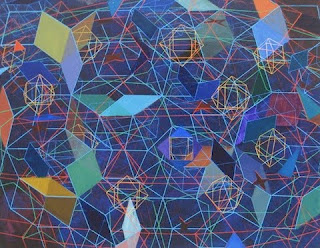Week 2: Math + Art
Applying mathematical principles to art helps shape artists’
perspectives and interpretations. In Flatland, Abbott uses geometry to portray society and gender,
where women are line segments and men are many-sided figures (Abbott 4-5).
Abbott created a fictional two-dimensional world where social stratification is
determined by the shapes’ number of sides; ultimately, the highest status is a
sphere, a three-dimensional object. Abbott’s interpretation of society
demonstrates the difference in perspective through mathematics. For example,
women are line segments, but from a side view, they are only a single point
(Abbott). Abbott’s social hierarchy suggests that lower levels of the hierarchy
will not understand a higher level’s perspective, such as with two-dimensional
versus three-dimensional object. Perspective allows artists to get a better understanding
of the world.
 |
| 4D Art by Tony Robbin http://fourdimensionalart.blogspot.com/ |
In addition to three-dimensional space, there exists a
fourth dimension. This fourth dimension have “encouraged artists to depart from
visual reality” (Henderson 2), thus creating abstract art. Human beings cannot visualize
the fourth dimension; therefore, mathematics depends on art for visualization.
 |
| Art by Piet Mondrian https://www.pinterest.com/magdalenaurbank/piet-mondrian/ |
Piet Mondrian is known for using geometry and primary colors in his abstract
pieces (Uconlineprogram). His work uses geometric shapes to build other shapes.
Mondrian uses proportion and scaling to create his work. His art conveys
reality and logic by expressing a balance in the world based on how the shapes
are drawn. The horizontal and vertical lines can be interpreted as opposing
forces in the world, since horizontal and vertical lines move in different
directions and are displayed differently.
Mandelbrot Set, a type of fractals – object with self-similarity – is another example that demonstrates mathematical art (Weisstein). Fractals can be represented by an iterative equation: z = z2+c (DlimitR). Mandelbrot set continues infinitely (“Mandelbrot Set”). Since it increases to infinity, art can portray the idea of a fractal clearly by showing the pattern within that one pattern. Understanding fractals, artists will have a deeper sense of patterning and for example, can create a biological model of blood vessels of the lungs.
Mathematicians and artists both depend on one another for interpretation
and concrete representation. This connection between math, science and art is
significant. Art is a visualization tool for science and math; math and science
work to interpret meaning and provide proof for abstract work. The contribution
of all three cultures helps create a well-understood world.
References
Abbott,
Edwin A. "Flatland A Romance of Many Dimensions." Flatland: A Romance of Many Dimensions. N.p., n.d. Web.
16 Apr. 2017.
DlimitR.
"Fractals - Mandelbrot." YouTube. YouTube, 17 June
2006. Web. 16 Apr. 2017.
Henderson,
Linda Dalrymple. "The Fourth Dimension and Non-Euclidean Geometry in
Modern Art: Conclusion." JSTOR. The MIT Press,
n.d. Web. 16 Apr. 2017.
"Mandelbrot
Set." Mandelbrot Set -- from Wolfram
MathWorld. N.p., n.d. Web.
16 Apr. 2017.
Uconlineprogram.
"Mathematics-pt1-ZeroPerspectiveGoldenMean.mov." YouTube. YouTube, 09 Apr. 2012.
Web. 16 Apr. 2017.

Comments
Post a Comment